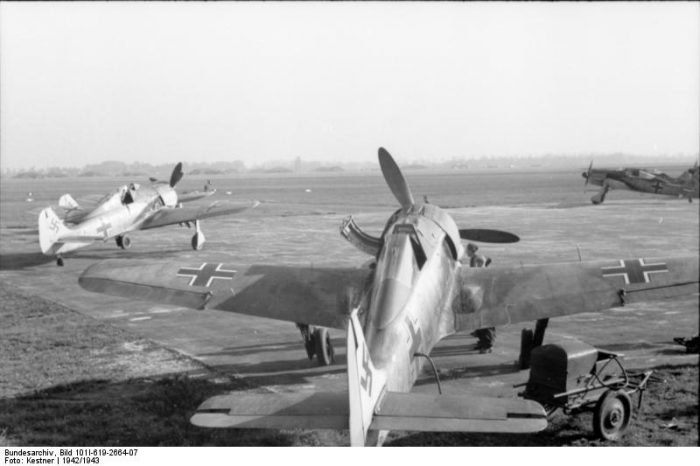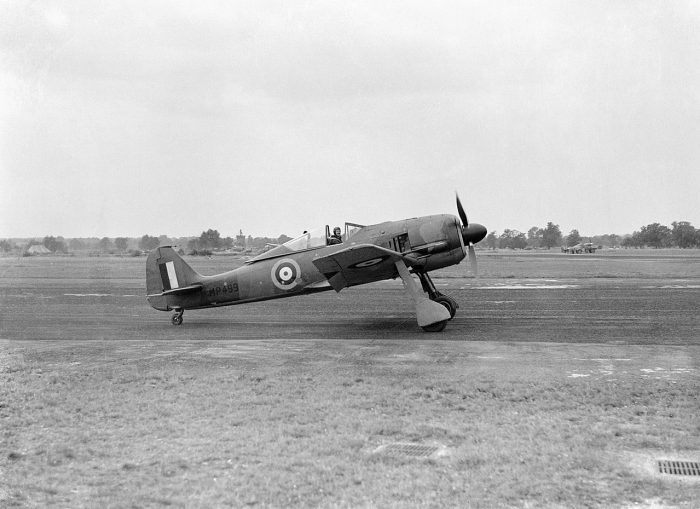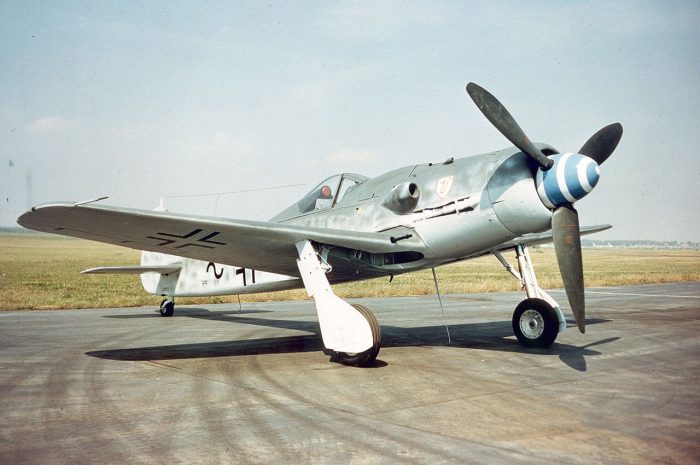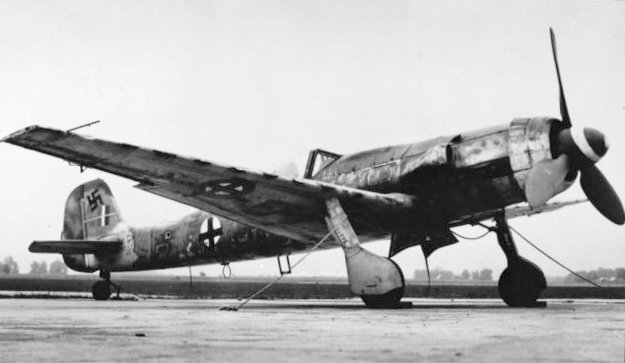Fw 190 – the Bird that Scared the Allies

The Focke-Wulf Fw 190 is widely considered to be the best fighter aircraft produced by the Germans during World War II, and even one of the best fighters produced by any nation during the war.
It was a truly feared aircraft, and rightly so.
Like many WWII fighters, its origins began in the 1930s. The German Ministry of Aviation (RLM) listed requirements to manufacturers asking for a fighter plane to fight alongside the Bf 109 and potentially replace it, if necessary.
The Bf 109 hadn’t even reached operational status by this point, but German brass were concerned that it could be beaten in the future by newer aircraft, so they wanted a new design in the works ready for that time.

Kurt Tank, Focke-Wulf’s chief of design from 1931-1945, presented his design, using a radial engine. The RLM’s interest was piqued with this, as it used a different engine to the Bf 109, meaning it wouldn’t draw DB 601 V12 engines away from Bf 109 production, for which demand was already outpacing supply.
Tank’s design originally used a BMW 139 engine, a huge 55.4 L 14 cylinder beast that could produce 1530 hp. The prototype aircraft with this engine used a large, odd looking nose cone, that allowed air to pass through the center to the engine for cooling. It was armed with a 7.92 mm and 13 mm machine gun in each wing, located near the fuselage firing through the propeller. It first flew in June 1939.

Two prototypes with this engine were made (V1 and V2), but in the end the BMW 139 would prove to be a nightmare to cool in this setup.
Instead, a redesign of this engine was used, the BMW 801, which came with a new BMW made cowling and cooling system. The first prototype with this engine was named the V5, and first flew in 1940.
The BMW 801 is quite a significant engine. It was a 41.8 L 14 cylinder twin row air cooled radial engine that produced around 1,550 hp at sea level. The engine was cooled by a fan just behind the propeller, which blew air over the hot cylinders.

The BMW 801 was designed with an automatic management system named the ‘command-device’, that hydraulically adjusted things like fuel mixture and flow, the supercharger, ignition timing, and the propeller pitch. At the time this system was sometimes regarded as more hassle than it was worth by pilots. Still, this incredible device can be seen as the earliest form of engine management systems now fitted to modern engines. The BMW 801 was Germany’s most produced radial engine.
Another unique feature of this aircraft was its use of solid push rods to control the flight surfaces, instead of cables. This was because cables would stretch over time, ‘loosening’ the feel of the aircraft and preventing precise control. The landing gear and guns were also operated electronically instead of hydraulically, which reduced the chances of being struck and damaged by enemy fire. Added to this was a vacuum formed bubble canopy that provided the pilot with great visibility.
Tank wanted this aircraft to be rugged and built for combat living conditions, which are usually untidy, be as resistance to damage from enemy fire as possible, and be easy to fly and maintain without much training.
The aircraft would enter production in June 1941 as the Fw 190 A-1. The A model used the BMW 801 engine, and was armed with 2 7.92 mm machine guns in the nose, and a 7.92 mm and 20 mm machine gun in each wing.
The Fw 190 A could reach a top speed of about 400 mph at 17,000 ft, and had a maximum altitude of 34,000 ft.

Its introduction in combat was a great shock to the Allies, who had nothing to match it. Even the Spitfire MK V struggled with the Fw 190, which outperformed it in almost every way. This was incredibly worrying for the Allies, as the new Fw 190 was already beating a well-upgraded variant of the Spitfire.
At medium-low altitude the Fw 190s had exceptional manoeuvrability and handling, and was well praised by pilots. The Fw 190 did however have poor handling at higher altitudes, often attributed to its relatively small wings and a supercharger setup for lower altitudes.
The Fw 190s were such an issue for Allied air superiority, that a commando raid was devised to capture one intact at a French airfield and fly it home for evaluation. Luckily this proved to be unnecessary when in 1942 a confused German pilot accidently landed his Fw 190 completely intact at RAF Penbury, an airfield in Wales. The pilot, Armin Faber, incorrectly thought he had landed on a German base in France, even wiggling his wings in celebration as he flew over those on the ground looking up in disbelief.

The British inspected the aircraft to the last nut and bolt, in order to develop a counter. This resulted in the Spitfire Mk IX, a version that could finally match the Fw 190.
Due to the fast pace of warfare, the Fw 190 was continuously upgraded throughout the war, with far too many variants to dive into here, but it essentially came in 3 main series. The A series was the primary fighter version, the D series improved the A series’ high altitude performance, while the F and G series were focused on ground attack.
A few notable models were the Fw 190 A-3, which saw the introduction of an improved BMW 801 D-2 engine in 1942. This new engine increased horsepower up to almost 1,700 hp, with a top speed of 430 mph. Water-methanol injection provided up to 10 minutes of emergency power which when used, would allow the BMW 801 to produce just shy of 2,000 hp.
Another variant, the Fw 190 A-9 introduced in late 1944, used an again upgraded BMW 801S, that produced 2,000 hp. An even more powerful engine, the BMW 801F-1 was planned which would have produced 2,370 hp, but the war ended before it could be realised.
The Fw 190 design suffered at higher altitudes of around 25,000 ft and above, a fact which was known early in its development and was an issue that harmed its interceptor capabilities. This was continuously worked on throughout its life, culminating in the aforementioned D ‘Dora’ series. This series is regarded as the pinnacle of German fighter development during the war.

The D series used a combination of 20 and 30 mm cannons to take down heavy Allied bombers, which they did so efficiently.
They also had the staple BMW 801 engine swapped for the Junkers Jumo 213, a 35.0 L liquid cooled inverted V12 engine with a two stage supercharger that produced 1,730 hp, and 2,070 hp with emergency power. It could reach 440 mph while at 37,000 ft.
The D series led into what is perhaps the ultimate development of the Fw 190 airframe; the Ta 152 H.
The Ta 152 H was a serious high-altitude weapon. Due to the short wings and medium altitude tuned engine of the Fw 190, it suffered from poor agility at high altitudes.
To remedy this, the Ta 152 H increased the Fw 190’s wingspan by over 4 meters. The larger flight surfaces greatly improved its high altitude performance. The cockpit was sealed and pressurised too.
It carried a 20 mm cannon in each wing, and one 30 mm cannon mounted within the V of the engine, firing out the nose.

Powering all this was the DB 213 V12. The extra weight of this engine meant the fuselage had to be lengthened to maintain its center of gravity.
Another Article From Us: Awesome Images of Aircraft Over the Pacific
The Ta 152 H became one of the fastest aircraft flown during WWII, reaching an incredible 472 mph at 40,000 ft. It could achieve a maximum altitude of 49,000 ft, almost 20,000 more than the standard Fw 190 A.
In one instance, Kurt Tank was flying an unarmed Ta 152 H in 1944 to a meeting, when he was intercepted by two P-51s. He escaped them by applying full throttle and boost, leaving the P-51s behind.
